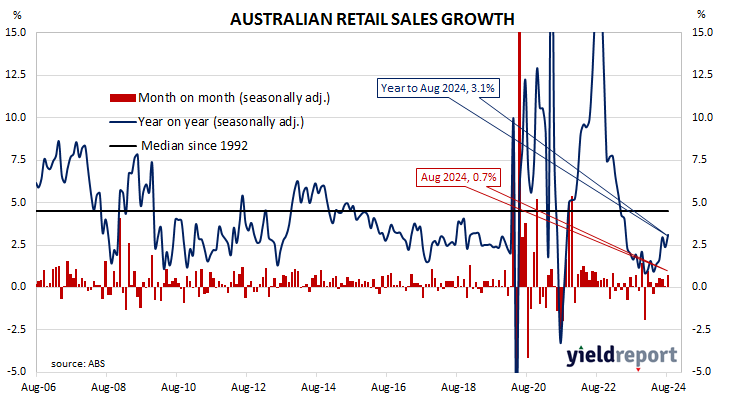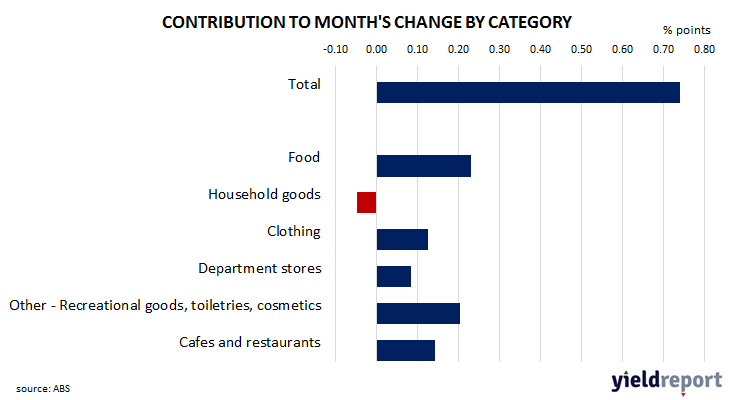Summary: Retail sales up 0.7% in August, more than expected; up 3.1% on 12-month basis; ANZ: lift broad-based, across all states, territories; ACGB yields rise modestly; rate-cut expectations soften, Feb cut still almost fully priced in; Westpac: sceptical about weather explanation, tax cuts the more likely driver; largest influence on result again from food sales.
Growth figures of domestic retail sales spent most of the 2010s at levels below the post-1992 average. While economic conditions had been generally favourable, wage growth and inflation rates were low. Expenditures on goods then jumped in the early stages of 2020 as government restrictions severely altered households’ spending habits. Households mostly reverted to their usual patterns as restrictions eased in the latter part of 2020 and throughout 2021.
According to the latest ABS figures, total retail sales increased by 0.7% on a seasonally adjusted basis in August. The result was greater than the 0.4% increase which had been generally expected as well as July’s 0.1% rise. Sales increased by 3.1% on an annual basis, up from July’s comparable figure of 2.4%.
“The lift was broad-based, with all states and territories and all categories, apart from household goods, seeing a lift in retail spending,” said ANZ economist Madeline Dunk. “It is likely that the lift to household disposable incomes from the Stage 3 tax cuts and cost-of-living measures supported spending in August.”
The update was released at the same time as August dwelling approvals figures and Commonwealth Government bond yields generally moved modestly higher across a flatter curve on the day. By the close of business, the 3-year ACGB yield had gained 3bps to 3.49%, the 10-year yield had added bp to 4.01% while the 20-year yield finished unchanged at 4.43%.
Expectations regarding rate cuts in the next twelve months softened a little, albeit with a February 2025 rate cut still almost fully priced in. Cash futures contracts implied an average of 4.305% in November, 4.22% in December and 4.11% in February 2025. August 2025 contracts implied 3.415%, 92bps less than the current cash rate.
“We are sceptical about the weather explanation and instead see tax cuts as the more likely driver,” said Westpac economist Neha Sharma. “This time last year, nominal retail sales growth was flat. This was despite August 2023 being the second warmest August since 1910. So while part of today’s results may be due to warm weather, we suspect the rise is more to do with the stage 3 tax cuts and other fiscal measures starting to filter through to spending.”
Retail sales are typically segmented into six categories (see below), with the “Food” segment accounting for 40% of total sales. Accordingly, the largest influence on the month’s total again came from this segment after sales rose by 0.6%.



